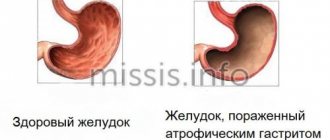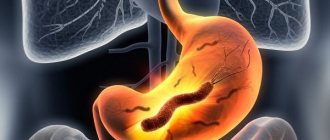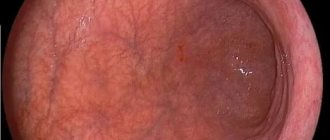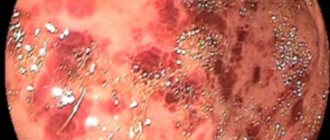Mixed gastritis is a type of inflammation of the gastric mucosa, combining the symptoms and clinical features of two to four types of gastritis. Most often, the pathology combines manifestations of superficial, hypertrophic, hemorrhagic and erosive forms of the disease. This gastropathology is very difficult to diagnose and treat. When one symptom is eliminated, signs of another form of the disease appear. What is mixed gastritis, the reasons for its development, symptoms and treatment in adults - all this will be discussed in detail in this article.
What is mixed gastritis
What is mixed gastritis? Mixed gastritis usually develops against the background of damage to the body by Helicobacter pylori, microorganisms whose infection leads to many stomach diseases. Most often, infection occurs through nutritional means, although the possibility of transmission from another person through close contact cannot be ruled out.
Mixed gastritis - what is it? As the name implies, mixed gastritis is a disease that includes symptoms of various types of gastritis.
Mixed gastritis is a disease that includes symptoms of various types of gastritis
With mixed gastritis, two, three or even four types of gastritis can be combined. In most cases, these are superficial, hypertrophic, hemorrhagic and erosive types.
Superficial gastritis is characterized by inflammation of the superficial layers of the gastric mucosa. Often superficial gastritis develops into another, more severe form. With hypertrophic gastritis, the stacks of glands thicken, which subsequently leads to thickening of the gastric mucosa and, ultimately, to the formation of adenomas and cysts.
Hemorrhagic gastritis is a form of gastritis in which the vessels of the stomach have increased fragility, and therefore point erosions and bleeding appear in the stomach. With erosive gastritis, damaged areas of the gastric mucosa appear in the stomach - erosion.
Attacks of mixed gastritis are often caused by excessive food intake, certain medications that irritate the mucous membrane, and alcohol. If you refuse spicy foods, medications that irritate the gastric mucosa, for example, tetracycline antibiotics, drink alcoholic beverages and follow a diet, these attacks pass quickly enough, without any long-term therapy.
Mixed gastritis is a serious illness, however, with a timely and accurate diagnosis, as well as following a certain treatment cycle, it can be completely cured. Mixed gastritis, despite the seriousness of this disease, can be completely cured. It is very important to contact a gastroenterologist at the first signs, because the sooner the disease is diagnosed, the easier, faster and more effective the treatment will be.
Under no circumstances should you self-medicate, this can only worsen the condition. And of course, it is worth remembering that it is much better to prevent the occurrence of a disease than to treat it. Therefore, you should not abuse alcohol, tobacco, or fatty foods. A healthy diet is the key to a healthy stomach.
Prevention
If there is a hereditary predisposition to gastritis or inflammation of the stomach has already happened before, you will need to follow preventive measures to prevent the disease. As a rule, such recommendations are given by the doctor when the patient is discharged.
What can be done:
- normalize nutrition;
- to refuse from bad habits;
- be examined regularly;
- do not ignore the primary symptoms of gastritis;
- take medications only as prescribed by a doctor;
- periodically visit specialized sanatoriums;
- monitor the quality of products.
With a competent approach to the treatment of mixed gastritis, you can get rid of the disease for a long time and even for life. It must be remembered that if inflammation of the stomach occurs once, it can recur again from exposure to any harmful factor. To prevent this from happening, you should come for preventive examinations on time and listen to the advice of your doctor.
Problems in the gastrointestinal tract are of concern to modern people more and more often. The diagnosis of “gastritis” is in the anamnesis of both young children and adults. But hardly anyone thinks about what type of illness a person has, because for the common man, any addition to the word gastritis is just a sound. But medicine has adopted its own classification, which makes it possible to correctly prescribe therapy to a patient.
Mixed gastritis is one of the forms of gastrointestinal damage and requires correct diagnosis in order to find the cause of the disease and eliminate it as soon as possible. What is mixed gastritis, its symptoms and what measures need to be taken for treatment should be known not only to the physician, but also to the patient.
Mixed gastritis
https://youtu.be/F0LW5p3LqkA
Mixed gastritis is a pathological process that results in damage to the gastric mucosa and, as a consequence, the development of an autoimmune process. Since we are talking about a mixed form of the disease, there is no clear etiological picture that would correspond only to this form of the disease.
Quite often, the development of mixed gastritis occurs due to long-term use of antibiotics and other medications that lead to digestive disorders. Doctors also note that abuse of hot and spicy foods can also lead to the development of one specific or mixed form of gastritis.
According to the nature of the development of this pathological process, they are distinguished: mixed chronic gastritis; mixed acute gastritis. The acute form of the disease is most treatable. With timely treatment and adherence to healthy eating rules, the disease can be cured completely.
Symptoms of mixed gastritis may differ, depending on the etiology of the disease and the predominant form of the pathological process. Due to the fact that at the initial stage there may be no signs or they are insignificant (short-term pain, periodically poor appetite), the patient does not seek medical help in a timely manner, which significantly worsens the prognosis. Therefore, at the first manifestations of symptoms, you should seek medical help, and not start treating gastritis with folk remedies.
Mixed gastritis is a pathological process resulting in damage to the gastric mucosa and, as a consequence, the development of an autoimmune process
Only a competent medical specialist can tell you how to treat a mixed type of gastritis correctly. As a rule, the program includes drug therapy and diet. Antibacterial therapy is carried out only if the disease has an infectious etiology. Drug therapy, as a rule, includes taking the following drugs: anti-inflammatory; bismuth-containing; proton pump blockers; antacids.
The patient's diet should consist only of lean foods, lean meats and fish; dishes should be steamed and consumed only in warm pureed form. It should be noted that if we are talking about the chronic form of this disease, then you should adhere to dietary nutrition throughout your life.
What mixed gastritis is and how to treat it correctly, only a qualified medical specialist knows. It is strongly not recommended to use any drugs or advice from traditional medicine, as this can lead to serious complications.
Diagnostics
Clinical and laboratory diagnosis of the symptoms of mixed gastritis helps determine the course of further treatment for the patient. At the appointment, the doctor identifies signs of the disease and collects an anamnesis of the disease.
Basic diagnostic tests:
- conducting laboratory tests of blood and urine;
- examination of the esophagus and stomach using fibrogastroduodenoscopy;
- scraping of the mucous membranes of the gastrointestinal tract.
To identify the pathogen, gastric juice is also analyzed using intubation. Additional X-ray examination of the pancreas and gallbladder is possible to identify the specific features of the diagnosis.
Important! Of particular importance is the acidity indicator of intragastric juice. To detect Ph, various tests are used, which are prescribed by a doctor.
Symptoms of mixed gastritis
Mixed gastritis is a disease in which damage to the gastric mucosa is manifested by clinical signs of various forms of this disease. In most cases, it combines the erosive, hemorrhagic, hypertrophic and superficial type of this pathology of the digestive tract.
Mixed gastritis often develops against the background of a certain pathological process - infection with pathogenic microorganisms Helicobacter pylori, which causes many stomach diseases.
At the onset of the disease, an inflammatory process develops, which in most cases covers only the superficial epithelium of the stomach.
At the onset of the disease, an inflammatory process develops, which in most cases covers only the superficial epithelium of the stomach.
In some cases, the gastric glands are damaged, but they do not die, but continue their functional activity.
Subsequently, the superficial form of mixed gastritis transforms into another form or is combined with hemorrhagic, hypertrophic or erosive changes in the mucosa. If we talk about the development of the clinical picture, it should be said that its features depend on many factors. A constant general symptom can be called deterioration of the patient’s condition with the active progression of any form of the disease. Stomach acidity may remain within normal limits, increase (hyperacid state) or decrease (hypoacid state).
The signs of mixed gastritis are similar to the clinical manifestations of chronic gastritis:
- discomfort in the epigastric (epigastric region);
- feeling like pain;
- feeling of “fullness” in the stomach;
- nausea and vomiting;
- a sharp decrease in appetite;
- dull or sharp pain in the epigastric region, which radiates to the back and left hypochondrium;
- intermittent belching of air or food;
- bloating.
It must be said that chronic mixed gastritis lasts quite a long time, provokes the constant appearance of similar symptoms and significantly worsens the general condition of patients.
Classification of mixed gastritis
Mixed gastritis has its own classification. Each type has certain characteristics and features:
- mixed superficial gastritis: the most common type of pathology. At the onset of the disease, inflammatory processes are observed in the surface layer of the stomach, in the epithelium. Their damage often spreads to nearby glands. Their normal work is disrupted. Then the disease passes into other forms;
- mixed atrophic gastritis: most often develops in people who did not start timely treatment and started the disease. This is also a common form of pathology. This gastritis appears against the background of a decrease in the number of gastric glands. As a result, other serious diseases develop. The cause of the development of the atrophic type of pathology is Helicobacter bacteria;
- chronic mixed gastritis: this form of the disease develops in people who do not start treatment on time. As a result, the disease progressed in an inflammatory form for a long time. The functioning of the gastric glands is disrupted. A feature of chronic mixed gastritis is long-term inflammatory processes that are only suppressed. After a while they appear again.
Mixed atrophic and superficial gastritis
Mixed atrophic gastritis is a disease of the gastrointestinal tract. Appears due to damage to the mucous membrane. Symptoms of several types of this disease are usually observed. Mixed superficial and atrophic gastritis is diagnosed quite often. It develops due to excessive workload in the body, improper eating patterns and unbalanced nutrition. In this case, it is necessary to treat each form of the disease.
Basically, mixed gastritis appears due to the activity of the bacterium Helicobacter pylori. Mixed superficial and atrophic gastritis appears due to the lack of treatment for the superficial form of the disease. This form of gastritis is a precancerous disease. The risk of malignant tumors increases if the process has spread to a significant part of the surface of the organ.
Symptoms of mixed superficial and atrophic gastritis
Basically, mixed gastritis appears due to the activity of the bacterium Helicobacter pylori.
First, an inflammatory process develops, which spreads exclusively to the superficial part of the organ. Damaged glands do not die, but continue to work. After a certain period of time, the disease takes on a different form. The affected glands die. Symptoms depend on many factors. The main manifestation of the disease is a general deterioration in health.
Acidity can remain at the same level for a long time, in certain cases it increases or decreases. The superficial form is similar in symptoms to chronic atrophic gastritis.
The main manifestations of mixed superficial and atrophic gastritis:
- feeling of fullness in the stomach;
- discomfort in the epigastric region;
- loss of appetite;
- nausea; vomit; bloating;
- Regular belching with an unpleasant odor;
- pain sensations appearing in the epigastric region, radiating to the back;
- sudden weight loss.
If you do not contact a medical facility in a timely manner, there is a risk of aggravating the current condition. You should consult a gastroenterologist immediately. Treatment of mixed superficial atrophic gastritis is aimed at destroying the pathogen Helicobacter pylori. It also includes medications that restore mucosal function and eliminate symptoms.
The specialist prescribes the following medications:
- "Metronidazole", "Clarithromycin", "Azithromycin" are aimed at destroying the bacteria;
- "Esomeprazole", "Omeprazole", "Rabeprozole" reduce the production of hydrochloric acid;
- "De-Nol";
- medications that affect gastric motility;
- antacids to reduce pain and other unpleasant symptoms;
- sedatives to reduce stress.
How to make a diagnosis
First, a patient with unpleasant symptoms consults a gastroenterologist. In some clinics, the first thing they do is visit a therapist to get a referral to a specialized specialist. In private clinics, as a rule, this approach is not required.
At the appointment, the doctor conducts an initial examination, learns from the patient about the time of onset of symptoms and previous factors. Be sure to draw up a picture of existing chronic diseases. However, only an instrumental examination with histological analysis (tissue sampling for subsequent biopsy) provides a complete picture of the disease.
The main examination method is FGDS. This is a procedure involving immersion of a special probe into the stomach through the oral cavity. A miniature camera shows the condition of the mucous membrane. Additionally prescribed:
- blood chemistry;
- submitting stool to determine bacteria;
- breath test to determine the presence of Helicobacter pylori;
- analysis of urine and gastric juice.
Only on the basis of all the described tests and examinations can an accurate and reliable diagnosis be made for further treatment.
Mixed atrophic gastritis
Mixed atrophic gastritis is a gastrointestinal disease when the mucous membrane is damaged. In this case, symptoms of several types of this disease most often appear at once.
Most often, the disease develops against the background of a specific pathological process. The cause of the disease is the microorganism Helicobater pylori. The bacterium can enter the human body in several different ways. Sometimes the microorganism can be transmitted through close contact with an infected person.
Quite often you can find mixed superficial and atrophic gastritis. The disease can develop when the body is overworked, lack of timely nutrition, or consumption of fast food.
Mixed atrophic gastritis is a gastrointestinal disease when the mucous membrane is damaged
If you do not consult a doctor in a timely manner, the disease can transform into cancer.
Treatment of mixed atrophic and superficial gastritis should cover each form of the disease. Only a gastroenterologist can choose the optimal course of treatment. A person suffering from an illness will be able to return to everyday life only after undergoing an appropriate course of treatment.
Symptoms of mixed atrophic gastritis
First of all, an inflammatory process develops, covering only the superficial part of the stomach. In this case, the damaged glands do not die, but continue to function.
After a certain point in time, the disease passes into another form of the disease, in which the damaged glands atrophy. In this case, the development of the clinical picture may depend on many factors. A common symptom of mixed atrophic gastritis is a deterioration in the general condition of the patient. As for acidity, it can remain unchanged for a long time, and sometimes increase or decrease. The main signs of the superficial form resemble the manifestation of chronic atrophic gastritis.
The patient may complain of the following symptoms:
- fullness of the stomach;
- discomfort in the epigastric region;
- change in appetite;
- state of nausea and vomiting;
- bloating;
- periodic belching with an unpleasant odor;
- pain arising in the epigastric region, which periodically extends to the back.
If you do not seek professional help in a timely manner, mixed superficial atrophic gastritis can further worsen the patient’s general condition.
Traditional methods
Treatment with “grandmother’s” remedies shows good results. It is advisable to combine them with medications under the supervision of the attending physician.
As additional therapy, infusions of yarrow herbs, calendula and shepherd's purse, decoctions of angelica, nettle and plantain are taken. Propolis and sea buckthorn oil are used as a healing agent.
Treatment with potato juice
Juice from chopped potatoes is considered cheap and easy to prepare. The drink has a beneficial effect on the mucous surface of the organ, normalizing the acidity of the stomach contents, helping to eliminate the taste of bitterness in the mouth and involuntary contractions of the stomach walls, and slightly increases the pepsin content.
To prepare the medicine, you should take a large potato, wash it thoroughly, and scrape off the skin. Grind on a plastic grater and squeeze through a clean piece of gauze. The volume will yield 60-70 milliliters of juice. Add a teaspoon of starch to it and mix. Drinking the mixture is prescribed twice a day. If acidity is high, 10-15 minutes before meals; if acidity is low, the interval should be 30-40 minutes. The period of use lasts up to ten to fourteen days. For prevention, resume taking it after a month. This mixture has the effect of a mild laxative. Taking “grandmother’s” medicine is completely harmless, does not threaten unexpected consequences and helps digestion.
Fresh cabbage juice exhibits similar properties. Before taking it, it should stand for three hours at a temperature of 18-22 degrees.
Healing with honey
Honey in combination with softened butter and aloe juice has an effective effect. To mix, take 200 g of all ingredients. Aloe juice is squeezed out after the leaves have been left in a dry place without access to sunlight for several days. It is better to place them in the refrigerator, after wrapping them in thick paper, and keep them for the required time at a temperature near 0 degrees.
The mixture is prescribed to be taken at a dose of 30 milligrams 20 minutes before starting a meal. Keep in the cold, warming up the required amount before taking.
If acidity is high, honey is taken one and a half hours before meals in the amount of two teaspoons. For greater effect, it is advisable to add an equal amount of softened butter. If the acidity is low, add one or two drops of lemon juice to the main ingredient.
Treatment of mixed gastritis using traditional medicine methods offers various mixtures based on honey. For example, a honey cocktail with milk and mumiyo shows good results with high acidity. Stir twenty-five grams of honey in a glass of heated milk, and after cooling, add 0.2 g of mumiyo. Drink 200 g in the morning and before bed for four weeks.
Collection of medicinal herbs in the fight against illness
To prepare the decoction you will need three parts of St. John's wort and 1 part each of wormwood, calendula, immortelle and plantain. Pour 70 g of dry mixture with 300 milligrams of heated water and keep in a steam bath for 20 minutes. It is recommended to drink the infusion at a dose of 60 milliliters, three to four times a day, 40 minutes before meals.
Propolis tincture
It is possible to buy it ready-made at a pharmacy, but it is advisable to prepare it yourself. 50 g of propolis is poured with half a liter of diluted alcohol and left at a temperature of 18-22 degrees for a week, shaking the bottle with the mixture from time to time. It should be taken an hour before meals, adding ten drops of tincture to 100 g of water.
An infusion of oatmeal in water works well as an enveloping agent.
It is forbidden to buy ready-made tinctures by hand. For production, sets of herbs are taken, purchased at a pharmacy, with proven quality ingredients.
If mixed gastritis is diagnosed, treatment is effective only if the attending physician’s instructions are followed and the rules of nutritional therapy are followed.
Mixed gastritis: symptoms and treatment in adults
Initially, the disease begins with inflammation of the surface layer of the gastric mucosa. With the development of the disease, this form of gastritis can transform into another, or be combined with erosive, hemorrhagic or hypertrophic changes in the mucosa. It is not known exactly how the pathological process will develop; only one thing is clear - gradually the patient’s condition will worsen.
If erosive formations appear on the surface of the mucosa, it makes sense to talk about the development of erosive gastritis. This form of inflammation can exist for a long time both with low and high acidity of the stomach.
The patient, if this disease develops, feels constant bloating, decreased appetite, pain in the epigastrium, and is tormented by belching, nausea or vomiting. Symptoms may worsen if the disease gets worse due to medication. In case of severe manifestations of this disease, the patient should be hospitalized and prescribed a course of treatment in a hospital.
With the development of the disease, this form of gastritis can transform into another or be combined with erosive hemorrhagic or hypertrophic changes in the mucosa
Therapeutic treatment begins only after identifying all the important features and factors of gastritis. In cases where an exacerbation of the disease occurs due to medication or overeating, it is enough to simply eliminate all provoking factors. It is necessary to understand that mixed gastritis should be treated by a professional gastroenterologist.
Attempts at self-medication in 95% of cases end in a deterioration of the patient’s condition. In severe cases, the patient is sent to hospital treatment and undergoes complex therapy, which includes not only taking medications, but also a strict diet. To combat pathogenic bacteria, antibiotic therapy is prescribed, and to relieve pain, the patient may be recommended to take antispasmodics and painkillers.
As for the diet for this form of gastritis, it can be different, depending on the acidity of the stomach:
- food is taken fractionally, in small portions;
- in the morning you need to drink a glass of boiled warm water;
- Spicy, salty, fried foods, preserves, and foods rich in fiber are excluded from the diet;
- the use of tobacco, alcohol and baked goods is completely excluded;
- animal fats in food must be replaced with vegetable ones;
- You should eat steamed, stewed or boiled dishes.
Treatment options
Symptoms and treatment of the disease depend on the incoming forms. If you immediately contact a doctor and prescribe medical therapy, the disease can be minimized in two to three days. Severe forms require a long time to recover.
Medication
It is appropriate to treat all signs of the disease; a comprehensive approach is chosen. The following are used in wrestling:
- Antacids - normalize the acidity of gastric juice (Phosphalugel, Maalox, Rennie). Usually prescribed in the presence of erosions.
- Anti-inflammatory drugs help destroy inflammation (Ibuprofen, Diclofenac).
- Antispasmodics – relieve pain (No-shpa, Papaverine).
- Enzyme preparations - taken to control the level of enzyme formation (Creon).
In many cases, antibiotics are prescribed.
Important: you should not prescribe treatment for yourself or choose medications without consulting a doctor. This will lead to undesirable consequences, even death.
How to treat mixed gastritis
Treatment of a mixed type of disease begins after diagnosis. This type of disease does not always respond well to treatment. It is worth remembering that if you have gastritis, a person should only consult a professional doctor, otherwise the therapy will not bring good results. It is not uncommon for people to be admitted to the hospital with an advanced form of the disease and with pronounced symptoms. In this case, inpatient treatment is indicated.
Since mixed gastritis of the stomach occurs due to the active activity of bacteria, treatment includes antibacterial therapy. To reduce pain, painkillers are prescribed. The acidity of the stomach is also taken into account; if necessary, it is normalized with the help of special medications. Treatment of a mixed type of disease must be comprehensive and aimed at eliminating unpleasant symptoms.
If a patient is diagnosed with gastritis, then he must follow a special diet. Otherwise, you will not be able to get rid of unpleasant symptoms. A diet for gastritis should be prescribed by a doctor depending on the nature of the damage to the gastric mucosa and the level of acidity.
But in any case, if a person has gastritis, then meals should be fractional. The diet includes steamed dishes at normal temperature. In the morning it is recommended to drink a glass of boiled water. Although patients are prescribed a diet, their diet must be balanced so that there is no lack of vitamins and nutrients. Also, if you have gastritis, you should avoid fried, fatty and canned foods. Under no circumstances should you smoke or drink alcoholic beverages.
Gastritis is a serious disease that should not be neglected; the sooner treatment begins, the greater the chance of recovery. Usually drug therapy and diet give good results. You should not ignore the symptoms of the disease and self-medicate, as serious complications may arise.
Sources:
https://gastritinform.ru/missanna.ru/mejdu-prochim/raznoe/smeshannyiy-gastrit-priznaki-i-osobennosti-lecheniya.html
https://simptomer.ru/bolezni/zheludochno-kishechnyj-trakt/2153-smeshannyj-gastrit-simptomy
What is mixed gastritis?
https://gastritinform.ru/tvoelechenie.ru/gastroenterologiya/priznaki-smeshannogo-gastrita-i-ego-lechenie.html
https://gastritinform.ru/fb.ru/article/307103/smeshannyiy-gastrit-chto-eto-takoe-opisanie-vozmojnyie-prichinyi-i-osobennosti-lecheniya
https://gastrit.guru/lechenie/smeshannyj-poverhnostnyj-i-atroficheskij-gastrit-lechenie.html
https://zhkt.guru/gastrit/vidy/atroficheskiy-1/smeshannyy-4
https://www.ja-zdorov.ru/blog/smeshannyj-gastrit-priznaki-i-lechenie/
Diet therapy: prohibited foods
Compliance with a diet for mixed gastritis of the stomach is usually based on the use of a treatment table. But in some cases, you can only get by by excluding from your daily menu foods that provoke exacerbations of the disease.
You will have to exclude or sharply limit the following foods and drinks in your diet:
- Alcoholic drinks;
- Confectionery products, including butter pastries;
- Salty and spicy varieties of cheese (it is also not recommended to eat fatty aged varieties of fermented milk products, for example, with mold);
- Pepper;
- A variety of spices, except natural herbs;
- Chocolate;
- Coffee (both natural and granulated instant);
- Sauces (both industrial and homemade - for example, adjika);
- Rye bread;
- Pasta;
- Fatty foods;
- Fried foods;
- Smoked meats;
- Millet;
- Barley grits;
- Fat sour cream;
- Beans.
All of the listed food sources can provoke a deterioration in the condition of the stomach walls with gastritis. If you stop using them, you will get a chance for their accelerated recovery after the defeats that have already taken place.
At the same time, to keep your diet nutritious and provide you with everything you need for healthy living, you must rely on certain foods.
Try to include the following food sources in your diet:
- Low-fat fish varieties;
- White meat chicken or turkey;
- Rabbit meat;
- Oatmeal;
- Buckwheat;
- Cottage cheese;
- Dairy and fermented milk products;
- Chicken eggs, boiled soft-boiled or in a bag;
- Beetroot;
- Carrot;
- Pumpkin;
- Zucchini;
- Apples;
- Raspberries;
- Strawberries;
- Rose hip.
You also need to be careful not to overload your stomach. To do this, you need to adhere to the principles of fractional nutrition - consume food in small portions 5-6 times a day.
Drinking regime is also extremely important in diet therapy. Try to drink at least two liters of pure distilled or filtered water per day. You can use medicinal herbal decoctions, but only after consulting a doctor. It is better to exclude tea and coffee. However, green tea is not prohibited in the diet.











